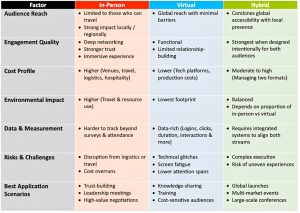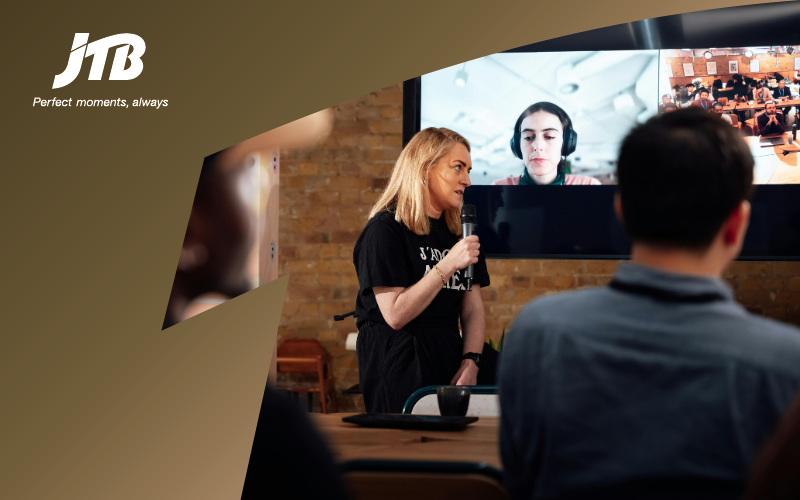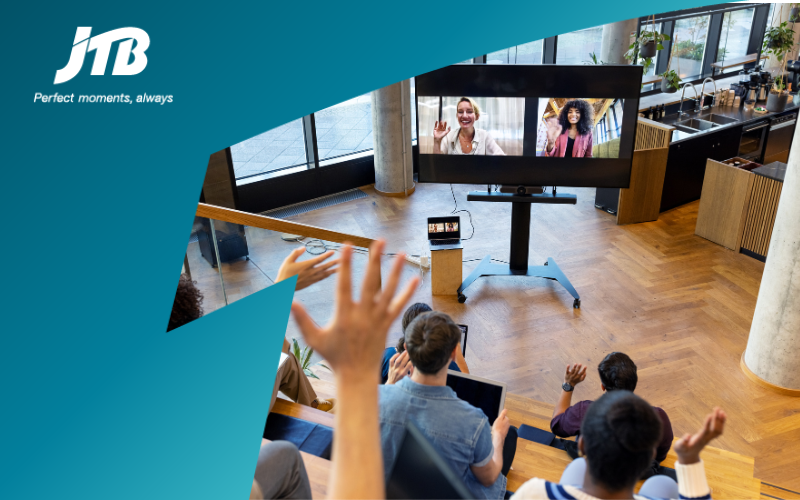Events today are no longer confined to hotel ballrooms or convention halls. Technology has expanded Meetings, Incentives, Conferences and Exhibitions (MICE) into three main formats – in-person, virtual and hybrid – each with distinct strengths and trade-offs. The challenge for organisations is selecting the right format for their business goals and ensuring it delivers measurable value. This is where Strategic Meetings Management (SMM) makes a difference.
Not long ago, events required significant time and resources to bring participants into one place, with disruptions hitting hard if travel or logistics failed. Technology changed that by enabling virtual participation, a trend accelerated by the Covid-19 pandemic.
Even as restrictions lifted, virtual events did not disappear – they blended into today’s standard hybrid format. For organisations, the question is no longer whether to run events virtually, in person or both, but which format will achieve the greatest ROI for specific objectives.
Strategic Meetings Management (SMM) provides the framework to evaluate and measure outcomes across formats, ensuring that event choices are guided by data rather than assumptions.
In-Person Events – Building Human Connection
Face-to-face interaction remains unmatched for building trust, deepening relationships, and enabling focused participation. Immersive experiences and organic networking make in-person formats invaluable. Yet they come with trade-offs: Higher costs, limited reach and greater environmental impact.
With SMM, organisations can address these challenges through stronger cost control, risk management and standardised delivery across venues and suppliers. Effectiveness is measured through attendance rates, engagement levels, satisfaction scores, cost per participant, and the quality or conversion rate of leads. This turns in-person events into accountable drivers of business value.
Virtual Events – Scale & Accessibility
Virtual formats excel in reach and accessibility. They lower barriers for global participants, reduce costs and generate rich data from digital interactions. However, they face challenges: screen fatigue, reduced engagement, weaker networking opportunities, and risks of technical disruption.
SMM helps mitigate these issues by centralising technology platforms, monitoring engagement and ensuring consistent delivery. Metrics such as registrations versus logins, participation duration, poll and click activity, technical issue rates and cost per participant provide a clear view of performance. With this data, organisations can finetune virtual formats for stronger impact.
Hybrid Events – Extending Reach with Impact
Hybrid events combine the reach of virtual with the connection of in-person, making them ideal for global launches, multi-market meetings, or events where flexibility is key. Attendees can choose the experience that suits them, and organisations benefit from greater visibility.
The complexity, however, is higher. Hybrid requires smooth coordination across two formats, higher costs than virtual alone, and careful design to avoid unequal experiences for onsite and online audiences.
SMM equips organisers to handle this complexity with standardised checklists, supplier coordination, and aligned data systems. Success is tracked through comparing online and onsite attendance, engagement by group, per-channel costs, and satisfaction scores by format. This ensures hybrid events deliver value that justifies the added investment.
Choosing the Right Format
There is no single “best” format. The right choice depends on the audience, budget and objectives of the event. SMM enables organisations to weigh these factors and draw on past data to make informed decisions.
A small internal meeting may work best in person, where trust and focus matter most. A global product launch may require a hybrid approach to combine live impact with virtual reach. A knowledge-sharing seminar could succeed as a virtual event, supported by interactive tools and on-demand access. In every case, SMM ensures the chosen format delivers measurable results.
Consistency Across Formats
In today’s MICE landscape, in-person, virtual and hybrid formats are all viable and valuable. The difference lies not in the format itself, but in how outcomes are planned, measured and improved. By applying SMM, organisations gain consistency, risk control and actionable insights from every event – building a cycle of learning and impact across formats.
For an at-a-glance comparison of the three formats, see our companion “Event Format Selection Guide” below!
Event Format Selection Guide: In-Person, Virtual or Hybrid?
Choosing the right event format is no longer about following trends. It is about aligning format with objectives, budget and audience needs. This guide offers a practical comparison of in-person, virtual and hybrid events to help you evaluate what works best. Strategic Meetings Management (SMM) provides the framework to apply these considerations consistently across all formats.
Key Considerations at a Glance

How to Use This Guide?
- Clarify your goals-Are you aiming to build relationships, share knowledge widely or maximise visibility?
- Define your audience – Local, regional or global? Time zones, travel restrictions and budgets matter.
- Set budget and resources – Factor in both direct costs (Venues, platforms, etc) and indirect costs (Travel time, staff capacity, etc).
- Consider engagement depth – Decide whether trust-building or broad reach is the priority.
- Measure against past data – Use SMM insights from previous events to compare outcomes and refine choices.
Why SMM Matters in Format Selection?
SMM ensures that whichever format you choose, outcomes are planned, measured and comparable. By applying consistent metrics across in-person, virtual and hybrid events, organisations can evaluate cost per participant, engagement levels and ROI – making format decisions evidence-based rather than speculative.
This guide is not a prescription, but a framework for decision-making. Each event is unique. By combining these considerations with SMM, organisations can select formats that deliver measurable impact, while adapting flexibility to changing business needs.
















